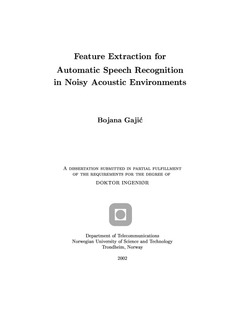| dc.contributor.author | Gajic, Bojana | nb_NO |
| dc.date.accessioned | 2014-12-19T13:29:40Z | |
| dc.date.available | 2014-12-19T13:29:40Z | |
| dc.date.created | 2002-06-21 | nb_NO |
| dc.date.issued | 2002 | nb_NO |
| dc.identifier | 125221 | nb_NO |
| dc.identifier.isbn | 82-471-5457-9 | nb_NO |
| dc.identifier.uri | http://hdl.handle.net/11250/249782 | |
| dc.description.abstract | This thesis presents a study of alternative speech feature extraction methods aimed at increasing robustness of automatic speech recognition (ASR) against additive background noise.
Spectral peak positions of speech signals remain practically unchanged in presence of additive background noise. Thus, it was expected that emphasizing spectral peak positions in speech feature extraction would result in improved noise robustness of ASR systems. If frequency subbands are properly chosen, dominant subband frequencies can serve as reasonable estimates of spectral peak positions. Thus, different methods for incorporating dominant subband frequencies into speech feature vectors were investigated in this study.
To begin with, two earlier proposed feature extraction methods that utilize dominant subband frequency information were examined. The first one uses zero-crossing statistics of the subband signals to estimate dominant subband frequencies, while the second one uses subband spectral centroids. The methods were compared with the standard MFCC feature extraction method on two different recognition tasks in various background conditions. The first method was shown to improve ASR performance on both recognition tasks at sufficiently high noise levels. The improvement was, however, smaller on the more complex recognition task. The second method, on the other hand, led to some reduction in ASR performance in all testing conditions.
Next, a new method for incorporating subband spectral centroids into speech feature vectors was proposed, and was shown to be considerably more robust than the standard MFCC method on both ASR tasks. The main difference between the proposed method and the zero-crossing based method is in the way they utilize dominant subband frequency information. It was shown that the performance improvement due to the use of dominant subband frequency information was considerably larger for the proposed method than for the ZCPA method, especially on the more complex recognition task. Finally, the computational complexity of the proposed method is two orders of magnitude lower than that of the zero-crossing based method, and of the same order of magnitude as the standard MFCC method. | nb_NO |
| dc.language | eng | nb_NO |
| dc.publisher | Fakultet for informasjonsteknologi, matematikk og elektroteknikk | nb_NO |
| dc.relation.ispartofseries | Dr. ingeniøravhandling; 2002:60 | nb_NO |
| dc.subject | speech recognition | en_GB |
| dc.subject | feature extraction | en_GB |
| dc.subject | noise robustness | en_GB |
| dc.title | Feature Extraction for Automatic Speech Recognition in Noisy Acoustic Environments | nb_NO |
| dc.title.alternative | Parameteruttrekning for automatisk talegjenkjenning i støyende omgivelser | nb_NO |
| dc.type | Doctoral thesis | nb_NO |
| dc.source.pagenumber | 111 | nb_NO |
| dc.contributor.department | Norges teknisk-naturvitenskapelige universitet, Fakultet for informasjonsteknologi, matematikk og elektroteknikk | nb_NO |
| dc.description.degree | dr.ing. | nb_NO |
| dc.description.degree | dr.ing. | en_GB |
